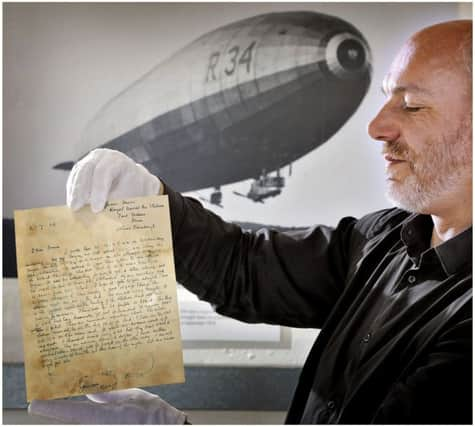Letter dropped from airship over Canada returns Scotland after 100 years


The handwritten note was dropped over Nova Scotia on 5 July 1919 from the R.34 – the day before it completed a record-breaking flight over the Atlantic.
It was written by Reverend George Davys Jones, a chaplain at RAF East Fortune in North Berwick, East Lothian.
Advertisement
Hide AdAdvertisement
Hide AdHe asked the crew to post it to his sister in Bournemouth, Dorset once they reached the USA – so it would become the first letter to be sent to the UK after crossing the Atlantic.
In his letter, Rev Jones described the successful flight as a “historic coup”.
The letter was discovered four months later on 8 November 1919, in Selma, Hants County, who forwarded it to Halifax, Nova Scotia. It was then posted back to England, where it arrived later that month.
Dated 2 July 1919, the letter reads: “I intend to give this letter to an officer on board the ship who will post it in or near New York to you. It will be interesting for you to get a letter which will be one of the first to cross the Atlantic by an airship and to cross from West to East. I hope it gets to you alright. There is every chance of them having a good voyage though the weather reports are not of the best.”
The century-old letter will now be exhibited at the town’s National Museum of Flight from today. It will be part of the museum’s Fortunes of War gallery, which explains the history of the RAF base.
The 634 ft R.34, nicknamed Tiny, departed RAF East Fortune in July 1919 and arrived on 6 July in Mineola, Long Island – after 108 hours of flying and with next to no fuel to spare.
The ambitious attempt took place just a few weeks after Alcock and Brown’s record-breaking west-east Atlantic flight, making it the first ever return flight across the Atlantic and the first east-west crossing by air.
The R.34’s trip involved the first arrival in the US by air when Major Pritchard parachuted from the airship to take charge of the hundreds of ground crew required.
Advertisement
Hide AdAdvertisement
Hide AdIt also included the world’s first human and feline trans-Atlantic aerial stowaways, Newcastle man, William Ballantyne and Wopsie the cat.
The National Museum of Flight’s assistant curator of aviation, Ian Brown, said the letter provides a “first-hand account” of the excitement felt by everyone at the airbase and in the village of East Fortune.
Mr Brown said: “It’s a fascinating addition to our collections that gives a first-hand account of the excitement on the ground here at East Fortune about this historic flight.
“The R34’s aerial adventure was front-page news both in the UK and the USA and demonstrated new technology that many believed would be the future of long-distance travel.”